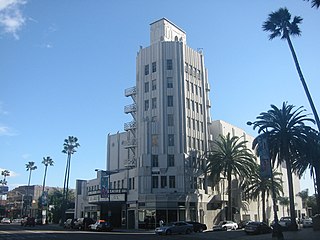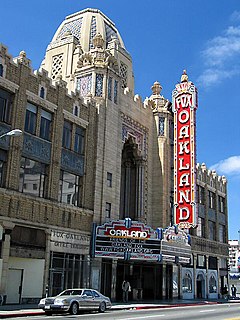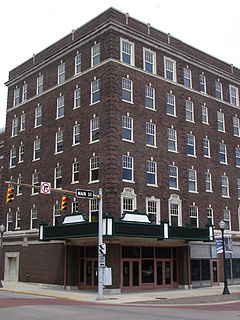
The Fox Theatre, a former movie palace, is a performing arts venue located at 660 Peachtree Street NE in Midtown Atlanta, Georgia, and is the centerpiece of the Fox Theatre Historic District.

The Fox Theatre is a performing arts center located at 2211 Woodward Avenue in Downtown Detroit, Michigan, near the Grand Circus Park Historic District. Opened in 1928 as a flagship movie palace in the Fox Theatres chain, it was at over 5,000 seats the largest theater in the city. Designed by theater architect C. Howard Crane, it was listed on the National Register of Historic Places in 1985 and was designated a National Historic Landmark in 1989 for its architecture. The area surrounding the Fox is nicknamed Foxtown. The city's major performance centers and theatres emanate from the Fox Theatre and Grand Circus Park Historic District and continue along Woodward Avenue toward the Fisher Theatre in the city's New Center.

El Capitan Theatre is a fully restored movie palace at 6838 Hollywood Blvd. in Hollywood. The theater and adjacent Hollywood Masonic Temple is owned by The Walt Disney Company and serves as the venue for a majority of the Walt Disney Studios' film premieres.

The Saban Theatre is a historic theatre in Beverly Hills, California, formerly known as the Fox Wilshire Theater. It is an Art Deco structure at the southeast corner of Wilshire Boulevard and Hamilton Drive designed by architect S. Charles Lee and is considered a classic Los Angeles landmark. The building was listed on the National Register of Historic Places on April 3, 2012.

The Pellissier Building and adjoining Wiltern Theatre is a 12-story, 155-foot (47 m) Art Deco landmark at the corner of Wilshire Boulevard and Western Avenue in Los Angeles, California. The entire complex is commonly referred to as the Wiltern Center. Clad in a blue-green glazed architectural terra-cotta tile and situated diagonal to the street corner, the complex is considered one of the finest examples of Art Deco architecture in the United States. The Wiltern building is owned privately, and the Wiltern Theatre is operated by Live Nation's Los Angeles division.

Alexander Gus Spanos was an American billionaire real estate developer, founder of the A. G. Spanos Companies, and the majority owner of the Los Angeles Chargers of the National Football League (NFL).

The Chicago Theatre, originally known as the Balaban and Katz Chicago Theatre, is a landmark theater located on North State Street in the Loop area of Chicago, Illinois, United States. Built in 1921, the Chicago Theatre was the flagship for the Balaban and Katz (B&K) group of theaters run by A. J. Balaban, his brother Barney Balaban and partner Sam Katz. Along with the other B&K theaters, from 1925 to 1945 the Chicago Theatre was a dominant movie theater enterprise. Currently, Madison Square Garden, Inc. owns and operates the Chicago Theatre as a performing arts venue for stage plays, magic shows, comedy, speeches, sporting events and popular music concerts.

The Coronado Performing Arts Center, in Rockford, Illinois, is a 2,400-seat theatre, designed by architect Frederic J. Klein. The theatre cost $1.5 million to build, and opened on October 9, 1927.

The Fox Oakland Theatre is a 2,800-seat concert hall, a former movie theater, located at 1807 Telegraph Avenue in Downtown Oakland. It originally opened in 1928, running films until 1970. Designed by Weeks and Day, the theatre is listed on the National Register of Historic Places. It was refurbished in the 2000s and reopened as a concert venue on February 5, 2009.

Fox Theatre is a historic movie theater located on Harbor Boulevard in Fullerton, California. Built in 1925 as part of the chain of Fox Theatres, the theater was closed and abandoned in 1987. The Fullerton Historic Theatre Foundation is currently in the process of fundraising and restoring the theater.

The Fischer Theatre was built in 1884 in Danville, Illinois, and was known as the Grand Opera House at that time. The grand opening was held on November 5, 1884. The lot on which it was built cost $6000, and the building itself cost $28,000 including furnishings. In 1912, the theatre was remodeled and upon its reopening on March 13, 1913, it was known as the Fischer Theater, after a member of its governing board. In 1929, the theater added equipment to project movies, and the exterior was remodeled when apartments and commercial space were added to the front of the building. A large pipe organ was used to accompany silent movies. In 1971, the theater was sold to the Kerasotes Theatres chain. The original seating capacity was about 900, which included the main floor, mezzanine, balcony and boxes. New seating was installed in 1971 when it became a Kerasotes theatre, giving the main floor a capacity of 600.

The Victory Theatre is a 1,950 seat venue in Evansville, Indiana. It is home to the Evansville Philharmonic Orchestra and also hosts local ballet and modern dance companies, theatre companies, and touring productions.

An atmospheric theatre is a type of movie palace design which was popular in the late 1920s. Atmospheric theatres were designed and decorated to evoke the feeling of a particular time and place for patrons, through the use of projectors, architectural elements and ornamentation that evoked a sense of being outdoors. This was intended to make the patron a more active participant in the setting.

The Saenger Theatre is a historic theater and contributing building to the Lower Dauphin Street Historic District in Mobile, Alabama. It was dedicated in January 1927. The Saenger Theatre is a Mobile landmark, known for its architecture and ties to local cultural history. The theater has been completely renovated in recent years with an upgraded electrical system, VIP facilities, new stage rigging and sound system. It is the official home of the Mobile Symphony Orchestra and also serves as the venue for movie festivals, concerts, lectures and special events.

The Majestic Theatre is a performing arts theater in the City Center District of Downtown Dallas. It is the last remnant of Theater Row, the city's historic entertainment center on Elm Street, and is a contributing property in the Harwood Street Historic District. The structure is a Dallas Landmark and is listed on the National Register of Historic Places.

The Oriental Theatre was a movie theater located at 828 SE Grand Street in the East Portland commercial district of Portland, Oregon. Built in 1927, the Oriental was a 2,038-seat movie palace designed by Lee Arden Thomas and Albert Mercier. The building's exterior was in the Italian Renaissance style. The interior had an "almost surreal appearance" created by interior designer Adrien Alex Voisin. It was built by George Warren Weatherly. Demolished in 1970, the theater was adjacent to the Weatherly Building, which remains standing.

The Mississippi Lofts and Adler Theatre is an apartment building and theater complex located in downtown Davenport, Iowa, United States. It is individually listed on the National Register of Historic Places by its original name, the Hotel Mississippi-RKO Orpheum Theater. The Hotel Mississippi was listed on the Davenport Register of Historic Properties in 2005. In 2020 the complex was included as a contributing property in the Davenport Downtown Commercial Historic District.

Middlesbrough Town Hall is a municipal facility located in Albert Road in Middlesbrough, North Yorkshire, England. It is a Grade II* listed building.



















